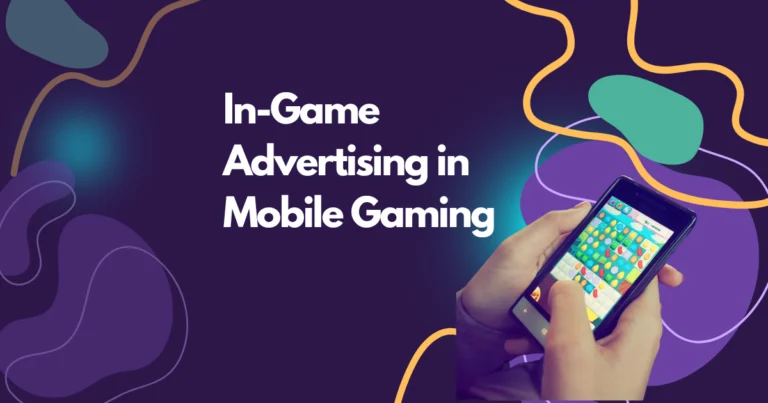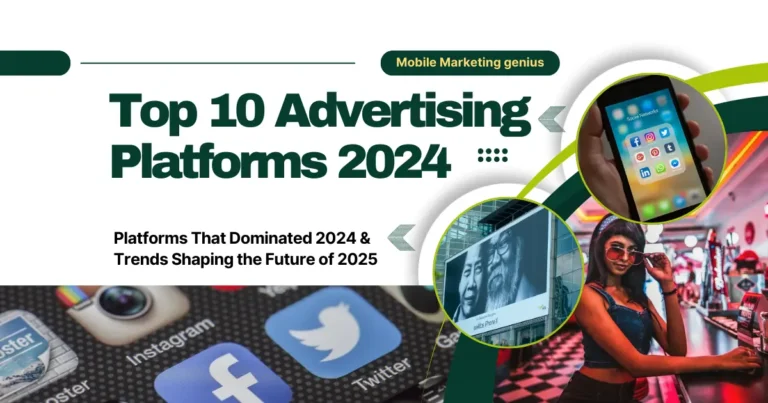Top Mobile Advertising Platforms: Supercharging Your Campaigns with Powerful Tools

Mobile Advertising Platforms have become indispensable in today’s digital landscape, enabling businesses to connect with their audience through mobile devices more effectively. As mobile devices dominate web traffic, it’s crucial for companies to leverage the right platforms to drive targeted campaigns and maximize reach in an increasingly competitive market.
In this article, we’ll explore some of the leading Mobile Advertising Platforms, their key features, how they work, the benefits and drawbacks, and examples of businesses that have successfully used them.
Table of Contents
1. Google Ads: A Leader in Mobile Advertising Platforms
Google Ads is one of the most prominent Mobile Advertising Platforms and continues to dominate mobile digital marketing. With the ability to target users across Google Search, YouTube, and millions of partner websites, it offers a comprehensive platform for businesses looking to capitalize on mobile traffic.
How It Works:
Google Ads offers a range of ad formats, including search ads, display ads, and video ads, allowing advertisers to target users based on keywords, demographics, and interests. It also has specialized app campaigns that focus on increasing app downloads and user engagement.
Key Features:
- Search Ads: Appear when users search for relevant keywords, driving high intent traffic.
- Google Display Network (GDN): Image and video ads that reach over 90% of internet users, particularly on mobile apps and websites.
- YouTube Video Ads: Engage mobile users with video content, capitalizing on the rise in mobile video consumption.
- App Campaigns: Optimized for app installs and in-app actions across Google’s platforms.
Advantages:
- Extensive reach across search, display, and video platforms.
- Strong targeting capabilities using keywords and interests.
- Ideal for industries with frequent mobile searches, like retail and travel.
Disadvantages:
- Competitive bidding can drive up costs, especially in saturated markets.
- Requires regular optimization and budget monitoring to remain cost-effective.
Business Users:
Google Ads is perfect for businesses aiming to increase visibility in mobile-heavy industries such as e-commerce, app development, and service-based industries. App developers and retailers benefit greatly from the comprehensive features offered by this Mobile Advertising Platform.
2. Facebook Ads: Social Media’s Mobile Powerhouse
With over 2.8 billion users, Facebook Ads is a top contender among Mobile Advertising Platforms. Its integration with Instagram and Messenger makes it a go-to platform for businesses looking to promote products, services, or apps through social media.
How It Works:
Facebook Ads allows businesses to target users based on demographics, interests, behaviors, and specific life events. The platform’s mobile app install ads are especially useful for developers wanting to drive downloads.
Key Features:
- Custom Audiences: Target ads based on detailed user data, including interests and demographics.
- Instagram Integration: Use Instagram Stories and Reels for immersive, mobile-first ads.
- Mobile App Ads: Specific ad formats designed to encourage app downloads and increase engagement.
- Messenger Ads: Personalized ads sent directly to users’ Messenger inboxes.
Advantages:
- Access to a massive, diverse user base with advanced targeting options.
- Strong visual ad formats, making it ideal for industries like fashion, food, and lifestyle.
- Seamless integration with Instagram for enhanced reach.
Disadvantages:
- Recent privacy changes have impacted targeting capabilities.
- High competition for ad space can increase costs.
Business Users:
Facebook Ads is ideal for businesses in consumer-facing industries such as retail, lifestyle, and fashion. Companies looking to promote apps or drive engagement through visual content will find it highly effective.
3. TikTok Ads: A Rising Star in Mobile Advertising Platforms
TikTok has emerged as a mobile-first Mobile Advertising Platform, especially popular among Gen Z and millennials. With over a billion users and an average daily usage time of 52 minutes, TikTok provides businesses with a unique opportunity to create engaging and viral content.
How It Works:
TikTok’s ads blend seamlessly into user feeds, allowing businesses to engage users with short, creative videos. The platform’s in-feed ads and hashtag challenges have proven effective for mobile apps looking to reach tech-savvy users.
Key Features:
- In-Feed Ads: Native ads that appear within the user’s feed, blending with the content.
- Branded Hashtag Challenges: Encourage user participation and content creation, often resulting in viral campaigns.
- TopView Ads: Full-screen ads that appear when users open the app, ensuring maximum visibility.
- Spark Ads: Boost organic content that’s already performing well.
Advantages:
- High engagement rates with younger, mobile-first audiences.
- Strong potential for viral marketing through user participation.
- Cost-effective for reaching large audiences with short-form video content.
Disadvantages:
- Requires highly creative, trend-driven content to resonate with TikTok’s culture.
- Best suited for brands that can quickly adapt to emerging trends and short-form content.
Business Users:
TikTok Ads is ideal for brands targeting younger audiences, particularly in industries such as entertainment, fashion, and gaming. Mobile apps looking to drive downloads and engagement can benefit greatly from TikTok’s highly engaged user base.
4. Apple Search Ads: Boosting App Downloads for iOS
Apple Search Ads is the top choice among Mobile Advertising Platforms for businesses looking to promote their mobile apps on iOS. It connects developers with users searching for apps in the App Store, making it a powerful tool for driving app downloads.
How It Works:
Apple Search Ads display ads based on user searches in the App Store, targeting users actively looking for relevant apps. With advanced targeting features, Apple Search Ads reach high-intent audiences, leading to higher conversion rates.
Key Features:
- Search Tab Ads: Ads that appear as users browse the Search tab in the App Store.
- Advanced Targeting: Use previous app downloads and search history to target the right audience.
- Cost Per Tap (CPT): Pay only when users tap your ad, ensuring cost-effective performance.
Advantages:
- Direct access to users searching for specific app-related content.
- High conversion rates, as users are already showing intent to download.
- Cost-effective for developers targeting iOS users.
Disadvantages:
- Limited to iOS users, excluding the large Android market.
- Primarily useful for app developers rather than traditional brands.
Business Users:
Apple Search Ads is essential for iOS app developers, particularly in industries such as gaming, fitness, and finance. It’s highly effective for businesses focused on app installs and user acquisition.
5. AdMob: Google’s Mobile Ad Network for Apps
AdMob is one of Google’s dedicated Mobile Advertising Platforms designed for app developers. It helps businesses monetize their apps through in-app advertising and allows for promoting apps across Google’s ad network.
How It Works:
AdMob lets developers display ads within their apps and earn revenue through clicks and impressions. It integrates seamlessly with Google Analytics, offering insights into ad performance and user behavior.
Key Features:
- In-App Ads: Includes banner ads, interstitials, and rewarded video ads to help monetize apps.
- Ad Mediation: Manage ads from multiple networks to maximize revenue.
- Google Analytics Integration: Gain insights into how users interact with ads.
Advantages:
- Enables app developers to effectively monetize their mobile apps.
- Full control over the types of ads shown within the app.
- Integration with Google’s vast ad network.
Disadvantages:
- Requires a large user base for significant revenue generation.
- Intrusive ads can negatively affect the user experience if not managed carefully.
Business Users:
AdMob is ideal for app developers in gaming, entertainment, and other industries that rely heavily on in-app monetization. It’s a powerful platform for those looking to generate revenue while promoting their apps across Google’s ad network.
6. Conclusion
Selecting the right Mobile Advertising Platforms is critical for businesses looking to optimize their mobile advertising strategy. Each platform offers distinct advantages that cater to different business goals, whether it’s increasing brand awareness, driving sales, or promoting a mobile app marketing campaign. From the broad reach of Google Ads and Facebook Ads to the more specialized platforms like TikTok Ads and Apple Search Ads, businesses can tailor their approach to target specific demographics and user behaviors.
In today’s mobile-first world, integrating these platforms into a comprehensive mobile advertising strategy ensures that businesses can engage users at the right time with the right message. This is especially important for companies focusing on mobile app marketing, as platforms like AdMob and Apple Search Ads provide targeted solutions to boost app installs and user engagement.
By leveraging the capabilities of these Mobile Advertising Platforms, businesses can create impactful campaigns that not only drive user acquisition but also foster long-term loyalty and growth in a highly competitive mobile market. A well-executed mobile advertising strategy that combines reach, personalization, and innovation will help businesses stay ahead of the curve in an ever-evolving digital landscape.







4 Comments
Comments are closed.